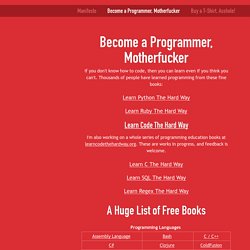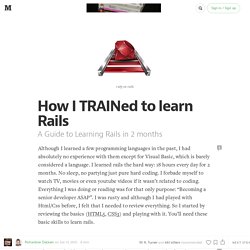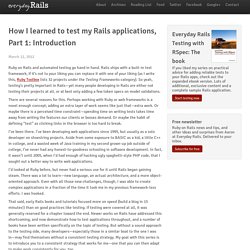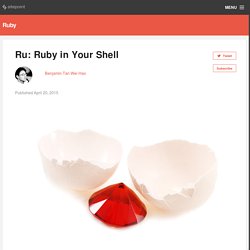

Ruby on Rails Screencasts - RailsCasts. Become a Programmer, Motherfucker. If you don't know how to code, then you can learn even if you think you can't.

Thousands of people have learned programming from these fine books: Learn Python The Hard Way Learn Ruby The Hard Way Learn Code The Hard Way I'm also working on a whole series of programming education books at learncodethehardway.org. Learn C The Hard Way Learn SQL The Hard Way Learn Regex The Hard Way Graphics Programming Language Agnostic NerdDinner Walkthrough Assembly Language Bash Clojure Clojure Programming ColdFusion CFML In 100 Minutes Delphi / Pascal Django Djangobook.com Erlang Learn You Some Erlang For Great Good Flex Getting started with Adobe Flex (PDF) Forth Git Grails Getting Start with Grails Haskell Java JavaScript JavaScript (Node.js specific) Latex The Not So Short Introduction to LATEX (perfect for beginners) Linux Advanced Linux Programming Lisp Lua Programming In Lua (for v5 but still largely relevant)Lua Programming Gems (not entirely free, but has a lot of free chapters and accompanying code) Maven Mercurial.
How I TRAINed to learn Rails — Ruby or Rails. A Guide to Learning Rails in 2 months Although I learned a few programming languages in the past, I had absolutely no experience with them except for Visual Basic, which is barely considered a language.

I learned rails the hard way: 18 hours every day for 2 months. No sleep, no partying just pure hard coding. I forbade myself to watch TV, movies or even youtube videos if it wasn’t related to coding. Everything I was doing or reading was for that only purpose: “Becoming a senior developer ASAP”. NO! When you decide to learn a language there are always mistakes that you make and realize later on as you are getting more experienced. Learning Ruby on Rails. How I learned to test my Rails applications, Part 1: Introduction. March 12, 2012 Ruby on Rails and automated testing go hand in hand.

Rails ships with a built-in test framework; if it’s not to your liking you can replace it with one of your liking (as I write this, Ruby Toolbox lists 32 projects under the Testing Frameworks category). So yeah, testing’s pretty important in Rails—yet many people developing in Rails are either not testing their projects at all, or at best only adding a few token specs on model validations.
There are several reasons for this. Perhaps working with Ruby or web frameworks is a novel enough concept; adding an extra layer of work seems like just that—extra work. I’ve been there. I’d looked at Ruby before, but never had a serious use for it until Rails began gaining steam. That said, early Rails books and tutorials focused more on speed (build a blog in 15 minutes!)
Who should read this series My testing philosophy At the risk of starting riots among the Ruby TDD and BDD communities, my approach focuses on the following: Ru: Ruby in Your Shell. The venerable sed and awk are extremely powerful text-processing tools.

In the hands of a master, these power tools can bend text into almost any shape and form. Unfortunately, I’m no master. More importantly, I don’t really want to invest too much time into learning sed and awk (or even bash!) , especially when most of my text processing tasks are ad-hoc. Enter Ru. Installing Ru Ru comes packaged as a Ruby gem. The Basics Before we get to the good bits, let’s learn a bit about how Ru lets us use Ruby to interact with the shell. Here’s the first example file for today’s exploration: Ruby on Rails Screencasts - RailsCasts. Ruby on Rails Tutorial (3rd Ed.) UT on Rails. Last year I held a series of non credit Rails courses for University of Texas Students, i’m happy to announce that i’ve been granted an Adjunct Professor position at the UT and I’m teaching a for credit course in Databases and Rails.

Lucky for you, i’m a sucker for online learning, so i’ll be putting all my course material online, right here. The Course This Ruby on Rails course is 10 weeks long and assumes you know very little about programming and have not used Ruby, Rails, or Databases previously. The videos are broken up by topic, so if you know one topic you can safely skip that video. Some weeks have exercises and quizes, this is the most important part of the course. I’m taking a fairly non traditional approach to teaching Rails, so even if you’ve been coding for a year or so, you’ll still likely get something out of the course, especially the exercises. Week 1: Introduction to Databases This first week we focus on databases and won’t get into Rails until the second week. More.